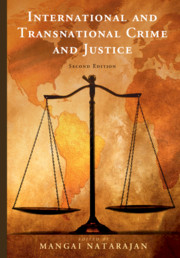Book contents
- International and Transnational Crime and Justice
- International and Transnational Crime and Justice
- Copyright page
- Contents
- Figures and Tables
- Preface
- About the Editor
- Notes on Contributors
- Introduction
- PART I OVERVIEW: TRANSNATIONAL CRIME
- PART II OVERVIEW: INTERNATIONAL CRIME
- PART III OVERVIEW: INTERNATIONAL AND TRANSNATIONAL CRIME RESEARCH
- World Map
- Index
- References
PART II - OVERVIEW: INTERNATIONAL CRIME
Published online by Cambridge University Press: 20 June 2019
- International and Transnational Crime and Justice
- International and Transnational Crime and Justice
- Copyright page
- Contents
- Figures and Tables
- Preface
- About the Editor
- Notes on Contributors
- Introduction
- PART I OVERVIEW: TRANSNATIONAL CRIME
- PART II OVERVIEW: INTERNATIONAL CRIME
- PART III OVERVIEW: INTERNATIONAL AND TRANSNATIONAL CRIME RESEARCH
- World Map
- Index
- References
- Type
- Chapter
- Information
- International and Transnational Crime and Justice , pp. 317 - 460Publisher: Cambridge University PressPrint publication year: 2019
References
REFERENCES
FURTHER READING
REFERENCES
FURTHER READING
REFERENCES
REFERENCES
WEBSITES
FURTHER READING
REFERENCES
WEBSITES
Amnesty International. www.amnesty.org/en/.
Human Rights Watch. www.hrw.org.
International State Crime Initiative. http://statecrime.org/about-isci/about-state-crime/.
REFERENCES
REFERENCES
REFERENCES
Details of case stories can be obtained from the following references listed below:
Case 1. Hildebrand, J. (2002, January 31). “Honour” killing in Sweden silences courageous voice on ethnic integration. Guardian. Retrieved from www.theguardian.com/theguardian/2002/jan/31/guardianweekly.guardianweekly1.
Case 2. Singh, A. (2011, September 3). Manoj-Babli honour killing. The Times of India. Retrieved from https://timesofindia.indiatimes.com/india/Manoj-Babli-honour-killing-SC-allows-plea-against-acquittal-of-accused/articleshow/9844060.cms.
Case 3. Government of Canada. (2016, December 30). Preliminary examination of so-called “honour killings” in Canada. US Department of Justice. Retrieved from www.justice.gc.ca/eng/rp-pr/cj-jp/fv-vf/hk-ch/p2.html.
Case 4. Ali, A. (2015, April 30). Honor killings in America. The Atlantic. Retrieved from
www.theatlantic.com/politics/archive/2015/04/honor-killings-in-america/391760/.
Case 5. Ansari, A. & Saifi, S. (2016, June 2). Pakistani woman dies after being set on fire for rejecting marriage proposal. CNN. Retrieved from www.cnn.com/2016/06/01/asia/pakistan-woman-fire-death/index.html.
REFERENCES
WEBSITES
International Society for the Prevention of Child Abuse and Neglect. www.ispcan.org/.
UN Human Rights Office of the High Commissioner – Convention on the Rights of the Child. www.ohchr.org/EN/ProfessionalInterest/Pages/CRC.aspx.
WHO. www.who.int/news-room/fact-sheets/detail/child-maltreatment.
REFERENCES
REFERENCES
WEBSITES
Crime Prevention and Criminal Justice Programme (ISPAC). ispac.cnpds.org.
International Scientific and Professional Advisory Council of the UN
Office of United Nations High Commissioner for Human Rights. www.ohchr.org.
United Nations Office on Drugs and Crime. www.unodc.org.
REFERENCES
WEBSITE
United Nations Treaty Collection. https://treaties.un.org/Pages/Home.aspx?lang=en.
REFERENCES
WEBSITES
Coalition for the ICC. www.iccnow.org.
ICC Preparatory commission work. www.un.org/law/icc/prepcomm/prepfra.htm or at www.jus.unitn.it/icct82/home.html.
International Criminal Court. www.icc-cpi.int/iccdocs/asp_docs/ASP8/OR/OR-ASP8-Vol.II-ENG-Part.A.pdf.
REFERENCES
REFERENCE
REFERENCES
WEBSITES
East Timor Hybrid Court. www.eastwestcenter.org/stored/pdfs/api061.pdf.
International Criminal Tribunal for the Former Yugoslavia. www.icty.org.
International Criminal Tribunal for Rwanda. www.ictr.org.
Special Tribunal for Lebanon. stl-tsl.org.
United Nations Treaty Collection. https://treaties.un.org/Pages/Home.aspx?lang=en.
REFERENCES
WEBSITES
African Charter on Human and Peoples’ Rights. https://au.int/en/treaties/african-charter-human-and-peoples-rights.
African Union. https://au.int/en/history/oau-and-au.
European Court of Human Rights, information documents.
www.echr.coe.int/Pages/home.aspx?p=court&c=#newComponent_1346149514608_pointer.
Organization of American States human rights webpage. www.oas.org/en/topics/human_rights.asp.
UN Human Rights Council. www.ohchr.org/EN/HRBodies/HRC/Pages/AboutCouncil.aspx.
REFERENCES
WEBSITES
Centre for the Study of Violence and Reconciliation. www.csvr.org.za.
International Centre for Transitional Justice. www.ictj.org.
International Institute for Democracy and Electoral Assistance. www.idea.int.
Program on Negotiation, Harvard Law School, and European Centre for Common Ground. www.truthcommission.org.
Truth and Reconciliation Commission. www.doj.gov.za/trc.
United States Institute of Peace. www.usip.org/library/truth.html.
REFERENCES
REFERENCES
WEBSITES
Amnesty International. www.amnesty.org.
Coalition for the International Criminal Court (CICC). www.coalitionfortheicc.org.
The Conference of NGOs in Consultative Relationship with the United Nations. www.ngocongo.org.
Criminologists without Borders. www.criminologistswithoutborders.org.
Human Rights Watch. www.hrw.org.
International Rescue Committee. www.rescue.org.
New York Alliance of NGOs on Crime Prevention and Criminal Justice. www.cpcjalliance.org.
NGO Branch, UN Department of Economic and Social Affairs. http://csonet.org/.
Penal Reform International. www.penalreform.org.
Promundo. https://promundoglobal.org.
Save the Children. www.savethechildren.net/.
Soroptimist. www.soroptimist.org/.
Transparency International. www.transparency.org/.
Women Living Under Muslim Laws. www.wluml.org.
World Society of Victimology. www.worldsocietyofvictimology.org.
REFERENCES
WEBSITES
International Centre for Transitional Justice. www.ictj.org/search-results?search=re.
John Braithwaite: War, Crime and Regulation. http://johnbraithwaite.com/?s=restorative+justice.



